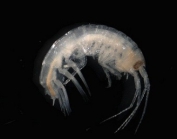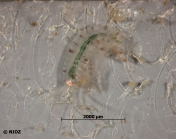
| About | | Search taxa | | Taxon tree | | Distribution | | Specimens | | Literature | | Images | | Stats | | Newsletter | | ID keys | | Talitraits | | Log in |
Amphipoda name detailsAtylus swammerdamei (H. Milne Edwards, 1830)
102131 (urn:lsid:marinespecies.org:taxname:102131)
unaccepted > superseded combination
Species
Dexamine gordoniana Spence Bate, 1857 · unaccepted > junior subjective synonym
marine,
recent only
(of Ampithoe swammerdamei H. Milne Edwards, 1830) Milne Edwards, H. (1830). Extrait de recherches pour servir à l'histoire naturelle des crustacés amphipodes. <em>Annales des Sciences Naturelles.</em> 20, 353-399; pl. 10-11., available online at https://www.biodiversitylibrary.org/page/6069923 [details]
Description These amphipods are highly flattened at the sides and measure up to 10 mm long. The species has a
whitish colour with...
Description These amphipods are highly flattened at the sides and measure up to 10 mm long. The species has a whitish colour with brown patches. The head has a small curved rostrum and slender antennae of equal size. Eyes are large and reniform. [details] Distribution In the 1976-1986 period Atylus swammerdami was observed across the entire Belgian part of the North Sea with a low...
Distribution In the 1976-1986 period Atylus swammerdami was observed across the entire Belgian part of the North Sea with a low distribution frequency and in low densities (up to 60 ind./m2). A similar distribution pattern was also found in the 1994-2001 period. The most remarkable difference was the high distribution frequency near the southern Zeeland Banks. This is where the highest densities were observed (up to 170 ind./m2). [details] Distribution A. swarnmerdami is found in the shallower part of the Dutch continental shelf. Both A. swarnmerdami and A. falcatus are...
Distribution A. swarnmerdami is found in the shallower part of the Dutch continental shelf. Both A. swarnmerdami and A. falcatus are absent from the oyster Ground. In the Delta area, it is found in the Oosterschelde, but has previously also been recorded from the Westerschelde (Cattrijsse et al., 1993). In literature the species is described from the lower intertidal to depths of about 50 m (Lincoln, 1979; Fish & Fish, 1989; Hayward & Ryland, 1990). [details] Distribution Ubiquitous, and often common
Distribution Ubiquitous, and often common [details] Distribution Europe, West and South Africa (Griffiths, 1974).
Distribution Europe, West and South Africa (Griffiths, 1974). [details]
Horton, T.; Lowry, J.; De Broyer, C.; Bellan-Santini, D.; Copila?-Ciocianu, D.; Corbari, L.; Costello, M.J.; Daneliya, M.; Dauvin, J.-C.; Fišer, C.; Gasca, R.; Grabowski, M.; Guerra-García, J.M.; Hendrycks, E.; Hughes, L.; Jaume, D.; Jazdzewski, K.; Kim, Y.-H.; King, R.; Krapp-Schickel, T.; LeCroy, S.; Lörz, A.-N.; Mamos, T.; Senna, A.R.; Serejo, C.; Souza-Filho, J.F.; Tandberg, A.H.; Thomas, J.D.; Thurston, M.; Vader, W.; Väinölä, R.; Valls Domedel, G.; Vonk, R.; White, K.; Zeidler, W. (2024). World Amphipoda Database. Atylus swammerdamei (H. Milne Edwards, 1830). Accessed at: https://www.marinespecies.org/amphipoda/aphia.php?p=taxdetails&id=102131 on 2024-04-16
Date action by
original description
(of Ampithoe swammerdamei H. Milne Edwards, 1830) Milne Edwards, H. (1830). Extrait de recherches pour servir à l'histoire naturelle des crustacés amphipodes. <em>Annales des Sciences Naturelles.</em> 20, 353-399; pl. 10-11., available online at https://www.biodiversitylibrary.org/page/6069923 [details]
basis of record Bellan-Santini, D.; Costello, M.J. (2001). Amphipoda. <em>in: Costello, M.J. et al. (Ed.) (2001). European register of marine species: a check-list of the marine species in Europe and a bibliography of guides to their identification.</em> Collection Patrimoines Naturels 50: pp. 295-308. (look up in IMIS) [details] additional source Bachelet, G.; Dauvin, J.-C.; Sorbe, J. C. (2003). An updated checklist of marine and brackish water Amphipoda (Crustacea: Peracarida) of the southern Bay of Biscay (NE Atlantic). <em>Cah. Biol. Mar.</em> 44(2): 121-151. (look up in IMIS) [details] Available for editors additional source Muller, Y. (2004). Faune et flore du littoral du Nord, du Pas-de-Calais et de la Belgique: inventaire. [Coastal fauna and flora of the Nord, Pas-de-Calais and Belgium: inventory]. <em>Commission Régionale de Biologie Région Nord Pas-de-Calais: France.</em> 307 pp., available online at http://www.vliz.be/imisdocs/publications/145561.pdf [details] additional source Griffiths, C. L. (1974). The Amphipoda of Southern Africa. 4. The Gammaridea and Caprellidea of the Cape Province East of Cape Agulhas. <em>Annals of the South African Museum.</em> 65: 251-336. [details] Available for editors additional source Lincoln, R. J. (1979). British marine Amphipoda: Gammaridea. <em>British Museum (Natural History).</em> 658 pp. (look up in IMIS) [details] Available for editors  Present Present  Inaccurate Inaccurate  Introduced: alien Introduced: alien  Containing type locality Containing type locality
From editor or global species database
Spelling Atylus swammerdamei. [details]From other sources
Description These amphipods are highly flattened at the sides and measure up to 10 mm long. The species has awhitish colour with brown patches. The head has a small curved rostrum and slender antennae of equal size. Eyes are large and reniform. [details] Distribution In the 1976-1986 period Atylus swammerdami was observed across the entire Belgian part of the North Sea with a low distribution frequency and in low densities (up to 60 ind./m2). A similar distribution pattern was also found in the 1994-2001 period. The most remarkable difference was the high distribution frequency near the southern Zeeland Banks. This is where the highest densities were observed (up to 170 ind./m2). [details] Distribution A. swarnmerdami is found in the shallower part of the Dutch continental shelf. Both A. swarnmerdami and A. falcatus are absent from the oyster Ground. In the Delta area, it is found in the Oosterschelde, but has previously also been recorded from the Westerschelde (Cattrijsse et al., 1993). In literature the species is described from the lower intertidal to depths of about 50 m (Lincoln, 1979; Fish & Fish, 1989; Hayward & Ryland, 1990). [details] Distribution Ubiquitous, and often common [details] Distribution Europe, West and South Africa (Griffiths, 1974). [details] Habitat Atylus swammerdami displays no clear preference for sediments with a specific grain size: the species is found in sediments with median grain sizes up to 550 μm with a low relative occurrence. However, a clear preference can be seen with regard to the mud content. Atylus swammerdami reaches a relative occurrence of over 40% in sediments with a mud content of 30-40%. The species is nevertheless also found in sediments with lower or higher mud contents (up to 50%). [details] Habitat A. swammerdami mainly lives in fine sediments with a low mud content, but also occurs in sandy (coarse) deposits and among algae (Lincoin, 1979; Fish & Fish, 1989; Hayward & Ryland, 1990). [details] Morphology A. swammerdami has a strongly compressed body of up to 10 mm in length. The head carries a small curved rostrum. The eyes are large and kidney-shaped. The first pair of antennae are shorter than the second pair. The abdomen consists of only 5 visible segments. The body is whitish in colour and is covered with brown patches (Lincoln, 1979; Fish & Fish, 1989). A. swammerdami differs from A. falcatus (q.v.) in lacking the large claspers on the robust third pereopod. [details] |

